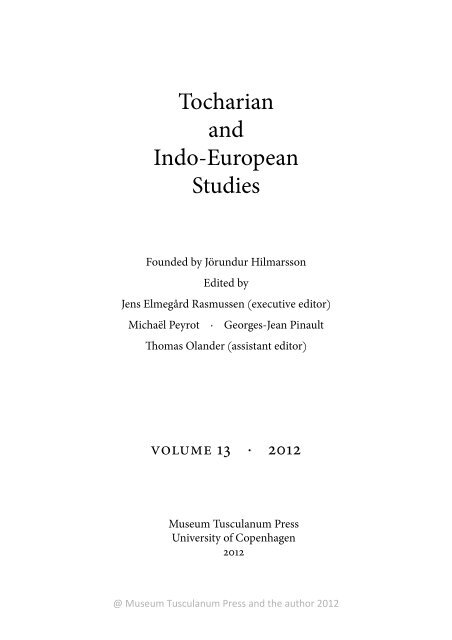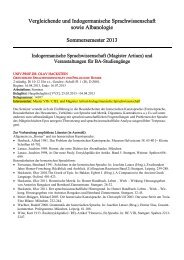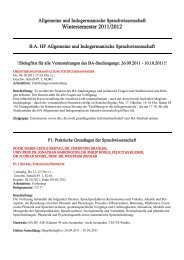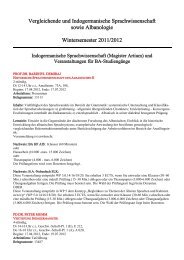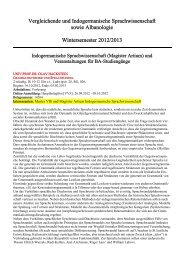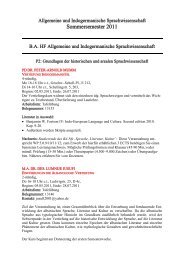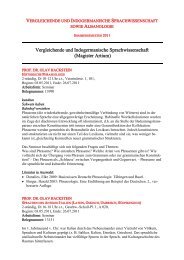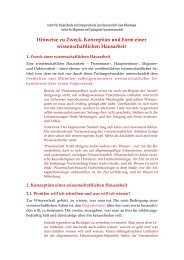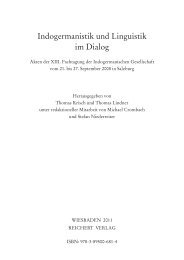Tocharian and
Tocharian and
Tocharian and
Create successful ePaper yourself
Turn your PDF publications into a flip-book with our unique Google optimized e-Paper software.
<strong>Tocharian</strong><br />
<strong>and</strong><br />
Indo-European<br />
Studies<br />
Founded by Jörundur Hilmarsson<br />
Edited by<br />
Jens Elmegård Rasmussen (executive editor)<br />
Michaël Peyrot · Georges-Jean Pinault<br />
Thomas Ol<strong>and</strong>er (assistant editor)<br />
Volume 13 · 2012<br />
Museum Tusculanum Press<br />
University of Copenhagen<br />
2012<br />
@ Museum Tusculanum Press <strong>and</strong> the author 2012
<strong>Tocharian</strong> <strong>and</strong> Indo-European Studies, Vol. 13<br />
© Museum Tusculanum Press <strong>and</strong> the authors, 2012<br />
ISSN 1012 9286<br />
ISBN 978 87 635 3964 7<br />
Published with support from:<br />
Roots of Europe – Language, Culture, <strong>and</strong> Migrations, University of<br />
Copenhagen<br />
Museum Tusculanum Press<br />
Njalsgade 126<br />
DK 2300 Copenhagen S<br />
www.mtp.dk<br />
@ Museum Tusculanum Press <strong>and</strong> the author 2012
Contents<br />
Hans Henrich hock<br />
In memoriam Werner Winter 1<br />
the editors<br />
Werner Winter: A bibliographical note 5<br />
Douglas Q. Adams<br />
Another look at three Kuci-Prākrit−<strong>Tocharian</strong> B bilinguals 7<br />
Douglas Q. Adams<br />
Shedding light on *leuk- in <strong>Tocharian</strong> <strong>and</strong> Hittite <strong>and</strong> the wider implications<br />
of reconstructing its Indo-European morphology 21<br />
gerd carling<br />
Development of form <strong>and</strong> function in a case system with layers:<br />
<strong>Tocharian</strong> <strong>and</strong> Romani compared 57<br />
ching chao-jung & ogihara hirotoshi<br />
On a <strong>Tocharian</strong> B monastic account kept in the Otani Collection 77<br />
olav hackstein<br />
The evolution of finite complementation in <strong>Tocharian</strong> 117<br />
Frederik Kortl<strong>and</strong>t<br />
The <strong>Tocharian</strong> s-present 149<br />
Melanie Malzahn<br />
Position matters: The placement of clitics in metrical texts of<br />
<strong>Tocharian</strong> B 153<br />
Ogihara Hirotoshi<br />
A fragment of the Bhikṣu-prātimokṣasūtra in <strong>Tocharian</strong> B 163<br />
@ Museum Tusculanum Press <strong>and</strong> the author 2012
Michaël Peyrot<br />
The <strong>Tocharian</strong> A match of the <strong>Tocharian</strong> B obl.sg. -ai 181<br />
Georges-Jean Pinault<br />
La parfaite générosité du roi Ambara (PK NS 32) 221<br />
michaël Peyrot<br />
Einleitung zu Peter Stumpfs „Anhang II: Analysen stufentypischer<br />
H<strong>and</strong>schriften“ 245<br />
† Peter Stumpf<br />
Anhang II: Analysen stufentypischer H<strong>and</strong>schriften 259<br />
Review<br />
Melanie Malzahn (ed.), Instrumenta Tocharica. (Reviewed by<br />
Doug hitch) 277<br />
@ Museum Tusculanum Press <strong>and</strong> the author 2012
The evolution of finite complementation in <strong>Tocharian</strong><br />
Olav Hackstein<br />
The present article explores the origins of finite complementation<br />
in <strong>Tocharian</strong>, employing methods of syntactic reconstruction<br />
that focus on the synchronic coexistence of source <strong>and</strong> target<br />
structures as well as the persistence of source-structure<br />
properties (e.g. preposing of relative <strong>and</strong> complement clauses,<br />
resumptive pronouns in correlative <strong>and</strong> matrix clauses). Like<br />
other Indo-European languages, <strong>Tocharian</strong> exemplifies the conversion<br />
of relative-correlative clauses into complement-matrix<br />
clauses. Interestingly, interrogative phrases served as an additional<br />
source of complementizers. <strong>Tocharian</strong> also displays an<br />
anomalous subtype of complementation, in which verbs of cognition<br />
<strong>and</strong> utterance are followed by a complementizer <strong>and</strong> direct<br />
speech. This construction, which is attested in other Indo-<br />
European languages as well, permits two explanations. It is either<br />
due to the reduction of a formulaic relative or interrogative<br />
clause, used to introduce direct speech, or it exemplifies a widely<br />
attested main-clause phenomenon which is pragmatically<br />
driven, allowing for greater assertiveness in the semantically dependent<br />
complement clause.<br />
1 The rise of finite complementation in Indo-European<br />
Within Indo-European, the zero-embedding of sentential complements<br />
after verbs of cognition <strong>and</strong> utterance is arguably original: it is more<br />
pervasive in the prehistory of all Indo-European languages the further<br />
@ Museum Tusculanum Press <strong>and</strong> the author 2012
118 olav hackstein<br />
back one goes in time. While many Indo-European languages have developed<br />
various forms of indirect speech reporting, restricting zeroembedding<br />
to informal <strong>and</strong> spoken registers, direct speech after utterance<br />
verbs remains the overall norm for instance in Anatolian (secondposition<br />
quotative particle -wa(r)), in Vedic (postposed quotative<br />
marker <strong>and</strong> similative iti ‘thus’) <strong>and</strong> in the Modern Iranian <strong>and</strong> Indo-<br />
Aryan languages.<br />
It is the purpose of the present article to explore the evolution of<br />
finite complementation in <strong>Tocharian</strong>, an extinct Indo-European language<br />
of Central Asia. Zero-embedding after verbs of cognition <strong>and</strong> utterance<br />
remains especially pervasive in <strong>Tocharian</strong>, as in the following<br />
passages from <strong>Tocharian</strong> B [1].<br />
(1) Toch. B zero-embedding after verbs of cognition <strong>and</strong> utterance1<br />
se pälskanaṃ Ø waike weñau <br />
rel think.prs.3sg.act Ø lie tell.sbjv.fut.1sg.act<br />
Who thinks: ‘I will tell a lie,’<br />
weskemane aiśträ Ø waike weskau <br />
tell.ptcp.prs.mp know.prs.3sg.act Ø lie tell.prs.1sg.act<br />
[<strong>and</strong> who] in telling it, knows: ‘I’m telling a lie.’<br />
postäṃ aiśträ Ø waike weñāwa<br />
afterwards know.prs.3sg.act Ø lie tell.pst.1sg.act<br />
[<strong>and</strong>] afterwards knows: ‘I have told a lie’ (PK NS 58 a4; Pinault 1994:<br />
137, 166)<br />
1 The glossing of the textual attestations cited in this article complies with the<br />
Leipzig glossing rules, as accessed on Oct. 23, 2011 at http://www.eva.mpg.<br />
de/lingua/resources/glossing-rules.php. In addition to these, the following<br />
abbreviations are used: Ø marks the absence of a complementizer; aor =<br />
aorist; correl = correlative demonstrative pronoun; mp = mediopassive;<br />
obl = oblique case; opt = optative.<br />
@ Museum Tusculanum Press <strong>and</strong> the author 2012
The evolution of finite complementation in <strong>Tocharian</strong> 119<br />
The prominence of direct speech <strong>and</strong> scarcity of indirect speech with<br />
utterance verbs is not a r<strong>and</strong>om pattern. Givón famously demonstrated<br />
the “systematic correlations … between the semantic structure of complement-taking<br />
verbs <strong>and</strong> the syntactic structure of their complements”<br />
(Givón 1980: 333) or, to put it differently, the correlation between the<br />
semantics of complement-taking predicates <strong>and</strong> the strength or looseness<br />
of syntactic binding. From Givón’s binding hierarchy, it emerges<br />
that speech reporting dem<strong>and</strong>s the least amount of syntactic tightness;<br />
for a schematic correlation of complement-taking predicates <strong>and</strong> binding<br />
strength, cf. Givón (1980: 369; 2001: 43, 49, 51).<br />
The synchronic propensity of zero-embedding to occur after utterance<br />
verbs even in languages that have developed indirect speechreporting<br />
was borne out by subsequent research, cf. e.g. Auer (1998: 288<br />
<strong>and</strong> 290) on present-day German, who demonstrated the increasing<br />
likeliness for non-overtly-embedded main clauses to occur along the<br />
scale of ‘hope’ > ‘see’ > ‘know’ > ‘think’ > ‘believe’ > ‘say’.<br />
The effect of the binding hierarchy is not confined to the synchronic<br />
distribution across the semantic domains of complement-taking predicates,<br />
but also has diachronic effects. Thus the decreased binding<br />
strength of verbs of cognition <strong>and</strong> utterance causes finite complementation<br />
to be established latest in these domains. Finite complementation<br />
typically develops first in factive adjunct clauses <strong>and</strong> spreads from there<br />
to complement-taking predicates, mostly in the order predicted by<br />
Givón’s binding hierarchy.<br />
The above generalizations are widely supported by data from the ancient<br />
Indo-European languages. For Latin, Scherer (1975: 236) observed<br />
the marked persistence of zero-embedding after verbs of cognition <strong>and</strong><br />
utterance (“Besonders oft findet sich Parataxe anstelle des A.c.I. bei<br />
“glauben”, “wissen” und “sagen”.”) The historical development from Latin<br />
to the Romance languages shows that finite complementation (mostly<br />
based on originally factive Latin quod <strong>and</strong> factive-causal quia) arose<br />
outside the domain of cognition <strong>and</strong> utterance verbs.<br />
Hittite similarly bears out the expected chronological layering. Sentential<br />
kuit-clauses occur first in the domain of adverbial adjuncts in<br />
Old Hittite, then gain ground in later stages. In Neo-Hittite, kuit exp<strong>and</strong>s<br />
its function to include indirect statements (e.g. after know or<br />
@ Museum Tusculanum Press <strong>and</strong> the author 2012
120 olav hackstein<br />
write), but never begins to be used with sentential complements of utterance<br />
verbs; for examples see Hoffner & Melchert (2008: 415, 426f.);<br />
for the relative chronology of the spread of complementizing kuit, cf.<br />
Cotticelli-Kurras (1995: 98f.).<br />
The <strong>Tocharian</strong> situation closely resembles that of Hittite. Complementizing<br />
clauses with Toch. B kuce, A kucne are especially prominent<br />
in the domain of adverbial adjuncts, but are only sparsely used as object<br />
complements after (verbal <strong>and</strong> nominal) predicates. Zero-embedding<br />
has clearly remained the norm in <strong>Tocharian</strong>.<br />
The comparatively rare occurrence of complementizing Toch. B kuce,<br />
A kucne after speech-act verbs <strong>and</strong> utterance-transmitting verbs (e.g.<br />
write, report) makes <strong>Tocharian</strong> an interesting test case for the evolution<br />
of finite complementation. The present investigation explores the evolution<br />
of finite complementation with complementizing Toch. B kuce, ce<br />
<strong>and</strong> Toch. A kucne.<br />
2 The methods of syntactic reconstruction<br />
Before turning to the evolution of sentential complementation in<br />
<strong>Tocharian</strong>, some methodological remarks are necessary, given that syntactic<br />
reconstruction differs significantly from morphonological reconstruction.<br />
While the latter concerns the reconstruction of forms <strong>and</strong> can<br />
rely upon sound laws <strong>and</strong> their reversal, syntactic reconstruction aims at<br />
reconstructing patterns of forms,2 <strong>and</strong> thus requires methods that go<br />
beyond those customarily employed in morphonological reconstruction.<br />
Three principal methods are the following.<br />
First, syntactic change need not be confined to the change of patterns<br />
alone. It also involves the complex interface between syntax <strong>and</strong> mor-<br />
2 Cf. in the same vein Winter (1984: 615 = Kleine Schriften II 809): “phonological<br />
<strong>and</strong> morphological reconstruction deal with manifestations of structures<br />
(…), whereas syntactic reconstruction (…) is concerned only with<br />
generalized patterns.”<br />
@ Museum Tusculanum Press <strong>and</strong> the author 2012
The evolution of finite complementation in <strong>Tocharian</strong> 121<br />
phonology <strong>and</strong> the combined change of syntactic patterns <strong>and</strong> morphological<br />
forms. For instance, the association of constructions <strong>and</strong> construction<br />
markers with semantic, prosodic, <strong>and</strong> morphological parameters<br />
necessitates the inclusion of morphonological reconstruction; an<br />
example is the reconstruction of patterns relating to the interface between<br />
syntax <strong>and</strong> prosody in Hackstein (2011). Furthermore, etymology<br />
as a method of syntactic reconstruction is not a priori out of the question.<br />
It comes into play e.g. in the morphonological reconstruction of<br />
construction markers. With due reserve, <strong>and</strong> heeding the caveat of the<br />
marker-structure fallacy (Harris <strong>and</strong> Campbell 1995: 284), the etymology<br />
of construction markers may <strong>and</strong> often does shed light on the history<br />
of the pertinent constructions. For one example, cf. the evolution of<br />
interrogative conjunctions from stimulus questions in various Indo-<br />
European languages (Hackstein 2004a).<br />
Second, linguistic change often involves incomplete replacement or<br />
even non-replacement of older forms <strong>and</strong> patterns, <strong>and</strong> syntactic change<br />
is no exception in this respect. The sources of syntactic constructions<br />
frequently persist, mostly in the guise of anomalies or minor or peripheral<br />
patterns or constructions. These then offer important hints for syntactic<br />
reconstruction. In the best of all cases, the syntactic prototypes of<br />
the target constructions are still attested.<br />
Third, the possibility <strong>and</strong> likeliness of a postulated syntactic change<br />
can be assessed typologically by referring to typological parallels. For<br />
further discussion of the latter two points, cf. Hackstein (2004c: 264f.).<br />
3 Types <strong>and</strong> history of complementizing clauses in <strong>Tocharian</strong><br />
In accordance with the three approaches to syntactic reconstruction set<br />
out in the previous paragraph, the following sections will explore the<br />
source(s) of finite complementation in <strong>Tocharian</strong>. To begin with,<br />
<strong>Tocharian</strong> attests the synchronic projection of some of the diachronic<br />
strata of complementizing clause types. Two basic pathways <strong>and</strong> source<br />
constructions may be discerned: relative-correlative clauses <strong>and</strong> interrogative<br />
clauses.<br />
@ Museum Tusculanum Press <strong>and</strong> the author 2012
122 olav hackstein<br />
3.1 Relative-correlative clauses<br />
<strong>Tocharian</strong> attests the reanalysis of relative clauses as complementizing<br />
clauses. We find a three-stage development, leading from relative-correlative<br />
structures to explicative factive clauses <strong>and</strong> eventually sentential<br />
complementation of complement-taking predicates. In the following, I<br />
will illustrate this continuum for <strong>Tocharian</strong> (3.1.1) <strong>and</strong> provide parallels<br />
from other languages (3.1.2).<br />
3.1.1 <strong>Tocharian</strong>: from relative to explicative/factive to complementizer<br />
At stage A, the reanalysis of relative clauses as factive clauses is furthered<br />
by a peculiarity of the information structure. Prototypical source<br />
structures are relative clauses whose nucleus encompasses a proposition<br />
<strong>and</strong> is represented by an abstract noun <strong>and</strong>/or a correlative pronoun. An<br />
information structure of this kind typically causes the focus to shift<br />
from the arguments of a given proposition to the proposition itself, thereby<br />
converting the former relative into a factive clause. Prototypical are<br />
clauses like [2].<br />
(2) Toch. B relative-correlative construction<br />
ce wessi (pu)ttewante3 snai paille<br />
rel.obl.sg.n we.gen Puttewante without justice<br />
yāmu<br />
ste<br />
do.pst.ptcp.nom.sg.m be.cop.prs.3sg<br />
[That] what Puttewante has done wrongly to us<br />
ce wat wäntare kakāmau<br />
rel.obl.sg.m or thing.obl.sg.m take.prt.ptcp.nom.sg.m<br />
3 Reading according to Ching (2011: 67).<br />
@ Museum Tusculanum Press <strong>and</strong> the author 2012
The evolution of finite complementation in <strong>Tocharian</strong> 123<br />
ste<br />
be.cop.prs.3sg<br />
or which item he has taken,<br />
su … nauṣameṃ papaikau<br />
correl.dem.nom.sg.m … before write.prt.ptcp.nom.sg.m<br />
ste<br />
be.cop.prs.3sg<br />
this has been written above. (Cp. 36.28−30, Pinault 1984: 24, 27)<br />
Here, the relative clause (ce … yāmu ste) propositionally conveys the<br />
content of the nucleus (su) <strong>and</strong> the object of writing. Due to the semantic<br />
overlap between the resumptive pronoun referring to the content of<br />
writing (su) <strong>and</strong> the proposition of the relative clause, a reanalysis of the<br />
relative clause as an object clause becomes possible, since [2a] propositionally<br />
implies [2b]. (Cf. Lühr 1993: 246.)<br />
(2a)<br />
(2b)<br />
What P. has done to us unjustly, has been written above.<br />
That P. has done us an injustice, has been written above.<br />
[2] provides an example of a typical correlative construction. The relative<br />
plus correlative ordering, which is still prominent in <strong>Tocharian</strong> (cf.<br />
Pinault 1997: 465, 467−70), represents an archaism inherited from PIE.<br />
Crucially, the relative pronoun ce (for kuce) here is governed by the verb<br />
yāmu ste.<br />
Upon its reanalysis, the factive relative clause occurs at first as an adverbial<br />
adjunct to certain complement-taking predicates, e.g. the fact<br />
that, as for the fact that, because of the fact that.<br />
The factive clause then exp<strong>and</strong>s its syntactic function to include the<br />
object of certain complement-taking predicates. This pathway of development<br />
is well attested <strong>and</strong> documented for a number of ancient Indo-<br />
European languages, cf. e.g. Rix (1979: 733−735).<br />
[3] provides an example of a relative-correlative construction in which<br />
the former relative is no longer verb-governed (cf. Rix 1979: 735) <strong>and</strong> has<br />
become a complementizer, but where certain traits of the source con-<br />
@ Museum Tusculanum Press <strong>and</strong> the author 2012
124 olav hackstein<br />
struction persist, namely the preposed relative clause <strong>and</strong> the resumptive<br />
pronoun in the main clause (ce yāmorsa ‘by this deed’).<br />
(3) Toch. B kuce (factive kuce) complementizing an abstract noun<br />
kuce ñiś ṣuk kauntsa wsāwa<br />
comp I.nom seven day.obl.pl.perl give.prt.1sg.act<br />
wno(lmeṃts s)n(ai) meṃtsñe,<br />
being.gen.pl without worry<br />
That I have given to the beings seven days long without worrying<br />
kuce =ṣp pudñäkte (ṣuk kauṃ kakāwa<br />
comp =<strong>and</strong> Buddha seven day.obl.pl invite.prt.1sg.act<br />
sāṅkämpa)<br />
Saṅgha.com<br />
<strong>and</strong> that I have invited Buddha to stay with the Saṅgha for seven<br />
days<br />
ce krent yāmorsa<br />
correl.dem.obl.sg.m good.obl.sg.m deed.obl.sg.perl<br />
källoym perne poyśiññe<br />
obtain.opt.1sg.act rank.obl.sg Buddha.adj.obl.sg.m<br />
by this good deed may I obtain the rank of a Buddha. (Toch. B 28 a8)<br />
Factive adjunct clauses complementizing (verbal) abstract nouns as in<br />
[3] <strong>and</strong> [6] below prepare the ground for their spread to complementtaking<br />
predicates, as can also be illustrated for Latin, Greek, Hittite,<br />
Vedic <strong>and</strong> Avestan (Rix 1979: 733f.).<br />
In [4] we have an explicative adjunct clause, again with persistent preposing<br />
<strong>and</strong> a resumptive pronoun.<br />
(4) Toch. B kuce tu (factive kuce) complementizing a pronominal adjunct<br />
kuce tu pwārntse yarke<br />
comp correl.dem.obl.sg.n fire.gen reverence.obl<br />
@ Museum Tusculanum Press <strong>and</strong> the author 2012
The evolution of finite complementation in <strong>Tocharian</strong> 125<br />
yamaṣṣeñcaṃ ṣeyeṃ<br />
do.prs.ptcp.nom.pl be.impf.3pl.act<br />
[because of] that they were worshipers of the fire,<br />
tu y(pa)rwe tuwak kottarcce<br />
corel.prn regarding.postp dem.obl.sg.n family.adj.obl.sg<br />
pelaik(n)e āksi añmassu kakā-me<br />
law.obl.sg proclaim.inf wishing call.prt.3sg.act-pron.3pl<br />
weñā-me-ś<br />
say.prt.3sg.act-pron.3pl-all<br />
given this/with respect to this/because of this he summoned them<br />
wishing to proclaim the Law of the family [<strong>and</strong>] spoke to them. (B<br />
108 b9)<br />
(The latter example was classified as causal by Thomas (1957: 75), repeated<br />
by Adams (1999: 182), but is better explained as explicative, as<br />
later accepted by Thomas 1964, who in his glossary (II 195) translates<br />
kuce … tu yparwe as ‘mit Rücksicht darauf, daß …’)<br />
Another peculiarity of the example in [4] is its onset kuce tu, <strong>and</strong> in<br />
particular the demonstrative pronoun tu. Complementizing kuce tu<br />
most likely has as its source the onset of an archaic clause-initial relative<br />
with inverted pronominal nucleus tu, as attested in [5].<br />
(5) Toch. B relative kuce tu plus correlative<br />
kuce tu ñāssa ritanträ,<br />
rel.obl.sg.n correl.dem.obl.sg.n greed.perl seek.sbjv.3pl.mp,<br />
Which one they long for greedily,<br />
kwri cau kallaṃ naumiye …<br />
if correl.prn.obl.sg.m obtain.sbjv.3sg jewel.obl.sg.m …<br />
if they obtain that jewel, … (B 231 b3)<br />
The occurrence of the pronominal nucleus tu after the relative kuce disambiguates<br />
the number <strong>and</strong> gender of the otherwise number- <strong>and</strong> gender-indifferent<br />
relative. Relative clauses like [5] can also be identified as<br />
@ Museum Tusculanum Press <strong>and</strong> the author 2012
126 olav hackstein<br />
the source of the formulaic explicative relative kuce tu ‘which is; namely’,<br />
for which see section 3.1.3 below.<br />
To sum up, the examples above illustrate the gradual conversion of<br />
relative-correlative structures into complementizing structures. Example<br />
[2] presents a relative-correlative whose semantic ambiguity would<br />
permit its reanalysis as a complementizing structure (cf. [2a−b]). Examples<br />
[3−4] show the former relative pronoun dependentially detached<br />
from the constituents of the subordinate clause in which it occurs, thus<br />
marking its innovative complementizing value. At the same time, however,<br />
we note the persistence of other features of the underlying relativecorrelative<br />
source construction, especially the preposing of the complementizing<br />
clause, which is typically found in combination with mainclause<br />
resumptive pronoun(s). Crucially, both the preposing <strong>and</strong> the<br />
resumptive pronoun are persistent properties of the underlying relativecorrelative<br />
source construction. (Note that the same phenomenon is<br />
found in Latin, Greek, Indo-Iranian, <strong>and</strong> in Hittite, where preposed factive<br />
kuit is followed by resumptive -at, -aš; cf. Rix 1979: 733f. <strong>and</strong> for Hittite<br />
Cotticelli-Kurras 1995: 96; for Sanskrit see examples [26−27] below.)<br />
As we see in [6, 7] <strong>and</strong> [18], this eventually changes. The complementizing<br />
clause begins to be postposed, <strong>and</strong> resumptive pronouns are no<br />
longer obligatory.<br />
(6) Toch. A kucne (factive) complementizing an abstract noun<br />
ṣokyo nu yaṃtrācāre nṣaṃ pukolyune …<br />
much.adv now mechanic I.loc confidence …<br />
laläkṣu<br />
show.ptcp.pst.nom.sg<br />
The mechanic has shown a lot of confidence in me<br />
kucne tāṣ taṃne kräṃtsonāṃ śomināṃ<br />
comp dem.obl.sg.f so beautiful.obl.sg.f girl.obl.sg.f<br />
snākyāṃ nṣaśśäl tärko<br />
alone.obl.sg.f I.com leave.ptcp.nom.sg.m<br />
in that he left this so beautiful girl alone with me. (A 6a4f.)<br />
@ Museum Tusculanum Press <strong>and</strong> the author 2012
The evolution of finite complementation in <strong>Tocharian</strong> 127<br />
(7) Toch. A kucne (factive) complementizing an adjective<br />
perāk te nu upādhyāy<br />
believable q now teacher.voc<br />
Is it believable now, oh teacher,<br />
kucne … ptāñkät ārkiśoṣṣaṃ pākär tāṣ<br />
comp … Buddha earth.loc apparent be.sbjv.fut.3sg.act<br />
that … a Buddha will appear on earth? (MSN 2 [II.1] b1, cf. Ji, Winter<br />
<strong>and</strong> Pinault 1998: 69)<br />
3.1.2 Italic, Indic, Germanic: from relative to explicative/factive to<br />
complementizer<br />
The entire pathway of development documented for <strong>Tocharian</strong> is paralleled<br />
by other languages, e.g. Italic. The Oscan example [8] exemplifies<br />
the source structure with correlative pronoun, abstract noun <strong>and</strong> explicative<br />
relative clause.<br />
(8) Oscan, correlative abstract noun plus explicative relative<br />
siom … idic tangineis deicum<br />
refl.acc.sg.m … correl.acc.sg.n decree.gen.sg.n say.inf<br />
that he pleads for such a decree<br />
pod valaemom touticom<br />
rel.nom.sg.n best.nom.sg.n public.nom.sg.n<br />
tadait<br />
ezum<br />
deem.prs.sbjv.3sg.act be.inf<br />
which he deems to be best for the people (Lu 1 = T[abula]B[antina] 1,<br />
9f.)<br />
A comparable structure has been converted into an explicative-factive<br />
complementizing clause with persistence of the correlative structure [9]:<br />
@ Museum Tusculanum Press <strong>and</strong> the author 2012
128 olav hackstein<br />
(9) Old Latin quod, complementizing an abstract noun<br />
tantum flagitium te scire<br />
correl.acc.sg.n crime.acc.sg.n you.acc.sg know.inf<br />
audivi<br />
meum<br />
hear.prf.1sg.act mine.acc.sg.n<br />
I heard you know about this big crime of mine<br />
quod cum peregrini cubui uxore<br />
comp with foreign.gen.sg.m sleep.prf.1sg.act spouse.abl.sg.f<br />
militis.<br />
soldier.gen.sg.m<br />
that I slept with the foreign soldier’s spouse. (Pl. Bacch. 1007f.)<br />
Examples of this construction with persistent pronominal nucleus are<br />
[10] <strong>and</strong> [11]:<br />
(10) Classical Latin, persistent correlative plus complementizer (hocquod<br />
construction)<br />
ne hoc quidem [dictum<br />
neg correl.acc.sg.n even [say.prf.ptcp.acc.sg.n<br />
putas],<br />
think.prs.2sg.act]<br />
[Do you think that] not even this was said<br />
quod … Taurum ipse transisti?<br />
comp … Taurus.acc.sg.m self.nom.sg.m surmount.prf.2.sg.act<br />
that he himself surmounted the Taurus? (Cic. fam. 3,8,6)<br />
(11) Classical Latin, complementizer plus persistent correlative (quodhoc<br />
construction)<br />
quod multa milia … paucos<br />
comp many.acc.pl.n thous<strong>and</strong>.acc.pl.n … few.acc.pl.m<br />
ceciderunt et ceperunt,<br />
kill.prf.3pl.act <strong>and</strong> capture.prf.3.pl.act<br />
@ Museum Tusculanum Press <strong>and</strong> the author 2012
The evolution of finite complementation in <strong>Tocharian</strong> 129<br />
That many thous<strong>and</strong> killed <strong>and</strong> captured (only) a few,<br />
hoc … vos scituros …<br />
correl.acc.sg.n … you.2pl.acc know.fut.ptcp.acc.pl.m …<br />
non credunt?<br />
neg believe.prs.3pl.act<br />
that you would know this, they don’t believe? (Liv. 38,49,10)<br />
By deletion of the correlative pronoun, sentential complementation of<br />
complement-taking predicates obtains. In accordance with the factive<br />
origin of the complementizer, this construction occurs first with factive<br />
verbs, then spreads to verbs of utterance [12].<br />
(12) Old Latin<br />
equidem scio iam filius<br />
anyway know.prs.1sg.act already son.nom.sg.m<br />
I for my part already know<br />
quod amet meus istanc<br />
comp love.prs.sbjv.3sg.act my.nom.sg.m dem.acc.sg.f<br />
meretricem.<br />
courtesan.acc.sg.f<br />
that my son loves this courtesan. (Pl. Asin. 52f.)<br />
In the same vein, Sanskrit provides examples of explicative-factive<br />
clauses with persistent correlative as in [13].<br />
(13) Vedic Sanskrit, correlative abstract noun plus complementizer<br />
vidúṣ ṭe asyá<br />
know.prf.3pl.act you.2sg.gen correl.gen.sg.n<br />
vīryàsya<br />
pūrávaḥ<br />
heroic.deed.gen.sg.act Pūru.nom.pl.m<br />
The Pūrus know of this heroic deed of yours<br />
púrō yád śradīr avtiraḥ<br />
fortress.acc.pl.f comp autumnal.acc.pl.f defeat.aor.2sg.act<br />
@ Museum Tusculanum Press <strong>and</strong> the author 2012
130 olav hackstein<br />
that you defeated their autumnal fortresses (RV 1.131,4)<br />
In Classical Sanskrit, such explicative yat-clauses begin to be used as the<br />
complements of verbs, notably with the persistence of the correlativerelative<br />
frame tat-yat. For examples, see below [26−27].<br />
Old West Germanic preserves the analogue of Latin hoc-quod <strong>and</strong> Sanskrit<br />
tat-yat, which is attested in old formulae; for a collection of attestations<br />
see Lühr (1982: 378−381).<br />
(14) Old High German, persistent correlative plus complementizer<br />
gihortun thaz<br />
hear.pst.3pl correl<br />
They heard that/the following<br />
thaz heilant … furifuori<br />
comp savior … through.travel.pst.sbjv.3sg.act<br />
that the savior … would travel through (Tatian 115,1)<br />
3.1.3 Formulaic explicative relative clauses in <strong>Tocharian</strong><br />
Beside the reanalyzed correlative of the <strong>Tocharian</strong> type illustrated in<br />
section 3.1.1, a subtype of complementizing kuce-clauses evolved from<br />
the reduction of correlative speech-act formulas like ‘which is’; cf. Hackstein<br />
(2004b: 354−356). Clauses of this type occupy an intermediate position<br />
between the proposition to be explained <strong>and</strong> the explanation.<br />
Toch. B kuce tu is typically found in commentaries. An example is [15],<br />
commenting on Mātr̥ceṭa, Śatapañcāśatka 144:<br />
(15) Toch. B explicative kuce tu<br />
saim-wästa kuce tu onolme …<br />
support-refuge.voc rel correl.dem.nom.sg.n being …<br />
‘o support <strong>and</strong> refuge [i.e., epithet of the Buddha], which is: being …’<br />
(B H add. 149.62 b2, ed. Couvreur 1966: 165f.)<br />
@ Museum Tusculanum Press <strong>and</strong> the author 2012
The evolution of finite complementation in <strong>Tocharian</strong> 131<br />
Furthermore, Toch. B kuce tu is given as the translation equivalent for<br />
Skt. yad uta ‘which is, namely, i.e.’ in bilingual fragments, e.g. B 528 a1,<br />
547 a3.4 An interpretation of explicative Toch. B kuce tu as ‘which is the<br />
following/as follows’ is unlikely in light of the fact that Toch. B tu is<br />
primarily anaphoric; see Stumpf (1971: 14, 96).<br />
A typological parallel is provided by Vedic (Sanskrit) explicative yad<br />
‘viz.’ (see Migron 1994[95]: 109ff.), also termed the “invariable yadconstruction”<br />
by Hock (2007: 88), cf. e.g.<br />
(16) Sanskrit explicative yad<br />
tad etat padanīyam asya<br />
dem.nom.sg.n dem.prox.nom.sg.n foot.trace dem.gen.sg.n<br />
sarvasya<br />
entirety.gen.sg<br />
This is the foot-trace of this entire (world)<br />
yad ayam ātmā<br />
rel.nom.sg.n dem.nom.sg.m ātman<br />
which is/namely ātman. (BĀU (M) 1,4,40f.; Hock 2007: 88)<br />
3.2 Interrogative clauses as prototypes of complementizing clauses<br />
In general, interrogative clauses are a frequent source to topic constructions<br />
in ancient Indo-European languages (Hackstein 2004b: 354-56). It<br />
can be argued that formulaic interrogative(-relative) clauses which<br />
served to raise a topic provided an additional source to complementizing<br />
kuce-clauses, see Hackstein (2004b). An example of a topic-raising<br />
adjunct clause is [17]:<br />
4 Cf. furthermore IOL Toch 187/ H.add.149.62 a2, b2, ed. Couvreur (1966:<br />
165f.), <strong>and</strong> the <strong>Tocharian</strong> rendering of Skt. kiñcit by Toch. B kuse tek warñai<br />
(Broomhead 1962 I: 153 <strong>and</strong> 1962 II: 107), which can be glossed as ‘which [is]<br />
whatever/so-<strong>and</strong>-so.’<br />
@ Museum Tusculanum Press <strong>and</strong> the author 2012
132 olav hackstein<br />
(17) Toch. B focal topic-raising interrogative(-relative) clause<br />
kuce … śak rūpī-āyatanta,<br />
foc.comp … ten Rūpāyatana.pl,<br />
sū rūpaskantä westrä.<br />
correl.nom.sg Rūpask<strong>and</strong>ha call.prs.3sg.mp<br />
What/How about the ten Rūpāyatana’s? (= as for the ten Rūpāyatana’s),<br />
this is called a Rūpask<strong>and</strong>ha. (B 192 b1)<br />
It is true that relative <strong>and</strong> interrogative pronouns cannot be formally<br />
distinguished in <strong>Tocharian</strong> B, but the inclusion of stimulus questions<br />
among the sources of complementizing kuce remains attractive in light<br />
of the kuce-construction with split complementation to be discussed in<br />
the next section. Formulaic stimulus questions typically lead to split<br />
complementation (the persistence of sentence boundaries of the underlying<br />
microtext structure; see Hackstein 2004a, 2011).<br />
4 An anomalous case: main-clause phenomena <strong>and</strong> split<br />
complementation in <strong>Tocharian</strong><br />
<strong>Tocharian</strong> also attests instances of a construction in which the complementizer<br />
is followed by direct speech. This construction is crosslinguistically<br />
well attested, <strong>and</strong> can be referred to as split complementation; its<br />
most significant trait is the absence of shift in person after the complementizer.<br />
Examples of the ce + direct speech construction in <strong>Tocharian</strong><br />
have been known at least since Broomhead (1962: 172f.).<br />
(18) Toch. B (ku)ce plus direct speech<br />
A poñ ce<br />
say.imp comp<br />
Say that<br />
B ñiś te-ñemtsa pañäkte saim<br />
I this-name.perl Buddha refuge.obl.sg.m<br />
@ Museum Tusculanum Press <strong>and</strong> the author 2012
The evolution of finite complementation in <strong>Tocharian</strong> 133<br />
yamaskemar.<br />
make.prs.1sg.mp<br />
I, named so-<strong>and</strong>-so, take the Buddha as refuge! (B H149.299a4, ed.<br />
Broomhead 1962: 172f., Pinault 1994a: 105, 1995: 15 = IOL Toch. 92,4,<br />
ed. Peyrot 2007)<br />
5 Split complementation in quotative complementation<br />
Main-clause phenomena after verbs of cognition <strong>and</strong> utterance have<br />
been known at least since Kieckers’s (1915: 14−34) survey of examples<br />
from a wealth of Indo-European <strong>and</strong> non-Indo-European languages. In<br />
the following, I provide additional examples from East Slavic, Ancient<br />
Greek, Old Armenian, <strong>and</strong> Sanskrit, in which the complementizer<br />
functions as a quotative particle, introducing the following discourse,<br />
which is direct discourse as indicated by the absence of person shift in<br />
[19b−27b].<br />
The Russian complementizer čto may introduce direct speech; cf.<br />
Eckert, Crome <strong>and</strong> Fleckenstein (1983: 186) (“Die indirekte Rede wurde<br />
im Aruss. wie die direkte Rede wiedergegeben”) <strong>and</strong> Issatschenko (1983:<br />
514f.). This construction is attested both for Old Russian [19] <strong>and</strong><br />
Modern Russian [20].<br />
(19) Old Russian quotative čto<br />
a i posle poučen’ja skazalŭ čto<br />
<strong>and</strong> after worship say.pst.sg.m comp<br />
And upon the worship he said that<br />
b ja vpred’ ne budu patriarxŭ<br />
I henceforth neg be.fut.1sg patriarch<br />
I will henceforth not be Patriarch. (Nikon [1605−1681], cited by<br />
Ivanov 1964: 439, Eckert/Crome/Fleckenstein 1983: 186)<br />
(20) Modern Russian quotative čto<br />
a vot teper’ traktirščik skazal, čto<br />
there now l<strong>and</strong>lord say.pst.sg.m comp<br />
@ Museum Tusculanum Press <strong>and</strong> the author 2012
134 olav hackstein<br />
The innkeeper just said that<br />
b ne dam vam est’<br />
neg give.fut.1sg you.dat.pl eat.inf<br />
I will not give you to eat … (Gogol’, Revizor, ed. 1951: 27, end of<br />
section 2.1)<br />
A similar construction can be found in Ancient Greek, which sporadically<br />
employs the complementizer ὅτι to introduce direct discourse (socalled<br />
“ὅτι recitativum”). One of the first examples comes from Herodotus<br />
(6th century B.C.) [21]; the construction is sparsely attested in Attic<br />
prose [22].<br />
(21) Ancient Greek quotative ὅτι<br />
a λόγον τόνδε ἐκφαίνει ὁ Πρωτεύς,<br />
word.acc.sg.m this.acc.sg.m voice.prs.3sg dem Proteus<br />
λέγων<br />
ὅτι<br />
say.ptcp.nom.sg.m comp<br />
Proteus voices this word, saying that:<br />
b ἐγὼ εἰ μὴ περὶ πολλοῦ ἡγεύμην …,<br />
I if not about a.lot.GEN.SG.N consider.aor.1sg.mp …<br />
ἐγὼ ἄν σε … ἐτεισάμην.<br />
I ptc prn.2sg.acc.sg … punish.aor.1sg.mp<br />
I, if I hadn’t considered highly …, I would have punished you. (Hdt.<br />
2.115,4)<br />
(22) Ancient Greek<br />
a Πρόξεινος εἶπεν ὅτι<br />
Proxenos say.aor.3sg comp<br />
Proxenos said that<br />
b αὐτός εἰμι, ὃν ζητεῖς.<br />
self be.prs.1sg rel.acc.sg.m look.for.prs.2sg<br />
I’m the one you are looking for. (X. An. 2.4,16)<br />
@ Museum Tusculanum Press <strong>and</strong> the author 2012
The evolution of finite complementation in <strong>Tocharian</strong> 135<br />
The same quotative use of an otherwise subordinating complementizer<br />
recurs with Old Armenian etcē/tcē [23−24]. In contrast to Ancient Greek<br />
ὅτι <strong>and</strong> East Slavic čto, however, the Old Armenian employment of etcē/<br />
tcē to introduce direct discourse is not exceptional but the norm (Jensen<br />
1959: 207).<br />
(23) Old Armenian quotative etcē/tcē<br />
a asacc-n etcē<br />
say.aor.3sg-prn comp<br />
that one said that:<br />
b z-bown … i jez darjowccicc<br />
acc-root … to you.acc.pl return.aor.sbjv.1sg<br />
I will give your root back to you. (M. X. II 67, p. 246; Thomson 1978:<br />
214)<br />
(24) Old Armenian<br />
a ayn asē tcē<br />
That.one say.prs.3sg comp<br />
One says that:<br />
b i merowm gewł covaccowl z-kov<br />
in poss.1pl village sea.creature acc-cow<br />
gorceacc<br />
give.birth.to.aor.3sg<br />
in our village a sea creature gave birth to a cow. (Eznik 25)<br />
Schmitt (1995: 244f.) drew attention to a similar construction in Old<br />
Persian:<br />
(25) Old Persian<br />
a yadi-pati maniyāha taya<br />
if think.prs.sbjv.mp.2sg comp<br />
If you should think about that<br />
@ Museum Tusculanum Press <strong>and</strong> the author 2012
136 olav hackstein<br />
b ciyakaram āha avā dayāva …<br />
how.many be.pst.3pl.act dem.nom.pl.f country.nom.pl.f<br />
How many were those countries … ? (DNa 38ff.)<br />
Finally, turning to Classical Sanskrit, finally, we encounter a relativecorrelative<br />
structure, which serves to introduce direct discourse<br />
[26−27].<br />
(26) Sanskrit relative-correlative tat-yat construction followed by direct<br />
speech<br />
a tat … vaktavyaṃ ca yac<br />
dem.nom.sg.n … tell.gerundive.nom.sg.n =<strong>and</strong> comp<br />
About this he ought to be informed (namely) that<br />
b c<strong>and</strong>ras tvām atra hrada<br />
moon.nom.sg pron.2sg.acc here lake.loc.sg<br />
āgacchantaṃ<br />
niṣedhayati<br />
go.prs.act.ptcp.acc.sg.m forbid.prs.caus.3sg.act<br />
the moon forbids you to go to this lake,<br />
yato ’smatparigraho ’sya hradasya samantāt<br />
for of.us.attendant dem.gen.sg.n lake.gen.sg around<br />
prativasati.<br />
live.prs.3sg.act<br />
for around this lake live my people. (Pañcatantra 160.24)<br />
(27) Sanskrit<br />
a tat … niveditaṃ yat<br />
dem.nom.sg.n … announce.pst.ptcp.nom.sg.n comp<br />
It (this) was announced that:<br />
b tava- ariḥ samprati bhītaḥ kvacit<br />
2sg.gen enemy now frighten.pst.ptcp somewhere<br />
pracalitaḥ saparivāra iti<br />
fled.PST.PTCP with.entourage.nom.sg.m quot<br />
@ Museum Tusculanum Press <strong>and</strong> the author 2012
The evolution of finite complementation in <strong>Tocharian</strong> 137<br />
your enemy, now frightened, has fled somewhere, accompanied by<br />
his entourage. (Pañcatantra 172.7)<br />
In sum, the phenomenon in question is hardly isolated, but parallels are<br />
of course not tantamount to an explanation. In the following section, I<br />
will suggest two mechanisms that typically generate split complementation.<br />
6 Explanation: Speech-act construction<br />
Two mechanisms may cause otherwise subordinating complementizers<br />
to be followed by main clauses, pragmatically conditioned ad-hoc mainclause<br />
phenomena <strong>and</strong> the reduction of formulaic linking clauses.<br />
6.1 Ad hoc main-clause phenomena<br />
There is ample evidence that certain constructions can have regular<br />
main-clause variants. For instance, main-clause phenomena are<br />
crosslinguistically frequent enough in the syntactic domains of cognition<br />
<strong>and</strong> utterance verb complementation <strong>and</strong> causal complementation<br />
so as not to be entirely r<strong>and</strong>om.<br />
a. Complementation after verbs of cognition <strong>and</strong> utterance<br />
Present-Day English paratactic that<br />
(28) He said that: No, I’m not gonna do this. (Overheard in Boston,<br />
January 2003. O.H.)<br />
b. Causal complementation<br />
(29) PD English paratactic because<br />
A Let’s go for a picnic, because:<br />
B isn’t it a beautiful day? (Lakoff 1984: 473)<br />
@ Museum Tusculanum Press <strong>and</strong> the author 2012
138 olav hackstein<br />
An especially clear example is furnished by Present-Day German weil<br />
plus verb-second (weil-V2), i.e. subordinating causal complementizer<br />
weil followed by (a prosodic break) <strong>and</strong> main-clause word order.<br />
(30) Present-Day German weil-V2 speech-act construction: supposition<br />
<strong>and</strong> justification<br />
a Er hat sicher wieder getrunken,<br />
pron.3sg.m have.prs.3sg surely again drink.prt.ptcp<br />
weil:<br />
causal.comp<br />
He’s no doubt drunk again, because<br />
b er läuft so deprimiert durch<br />
pron.3sg.m run.prs.3sg so depressed through<br />
die<br />
Gegend.<br />
art.acc.sg.f area.acc.sg.f<br />
he’s running around so depressed.<br />
(Selting 1999: 173; cf. Günthner 1996: 328)<br />
Recent research has established that weil-V2 typically occurs as a<br />
speech-act construction, i.e. weil-V2 typically serves to assert the preceding<br />
speech act (German Sprechaktbegründung). Thus [30b] provides<br />
a justification for the supposition made in [30a].<br />
By contrast, weil-Verb-Last introduces a presuppositionally linked<br />
cause (German Sachverhaltsbegründung), e.g. [31].<br />
(31) German weil-Verb-Last: propositionally causal link<br />
Er konnte nicht kommen, weil er krank war.<br />
He couldn’t come because he was ill.<br />
The recurrence of the phenomenon under the same syntactic <strong>and</strong> pragmatic<br />
parameters suggests that it is not to be conceived of as an infringement<br />
of grammatical rules <strong>and</strong> well-formedness or as an anacoluthic<br />
structure, but as a regular constructional subtype. Recent research<br />
has substantiated the claim that main-clause phenomena are related to<br />
@ Museum Tusculanum Press <strong>and</strong> the author 2012
The evolution of finite complementation in <strong>Tocharian</strong> 139<br />
<strong>and</strong> favored by certain syntactic <strong>and</strong> pragmatic parameters, especially by<br />
a pragmatically conditioned need for assertiveness; cf. Green’s observation<br />
(1976: 382ff.) that main-clause phenomena occur “basically, when<br />
the speaker desires to be understood as committed to the truth of the<br />
subordinate clause.”<br />
The pragmatic motivation behind this phenomenon has long been<br />
recognized. (The link between pragmatics <strong>and</strong> main-clause phenomena<br />
was first explicitly stated in Lakoff 1984.) Normally <strong>and</strong> under the classical<br />
conception, main clauses assert, while dependent clauses presuppose<br />
(Hettrich 1988: 24f.). Within the functional range of subordinate clauses,<br />
however, certain conceptual domains have a greater need (<strong>and</strong> allow<br />
greater leeway) for assertion than others. This demonstrably holds for<br />
complements governed by verbs of cognition <strong>and</strong> utterance, <strong>and</strong> for<br />
causal clauses. Verbs of cognition <strong>and</strong> utterance may refer to propositions<br />
that are factually true, or they may simply encode the subject’s<br />
(<strong>and</strong> speaker’s) assertion of a claim that the dependent proposition is<br />
true. Likewise, among the core usages of causal clauses is the statement<br />
of factual causes, but those causes may encode a (personal) justification.<br />
It is therefore not coincidental that we encounter main-clause phenomena<br />
especially frequently in the domains of cause, cognition <strong>and</strong> utterance.<br />
In short, main-clause phenomena are motivated by a conceptual<br />
structure which involves an increased need for performative instantiation.<br />
And it is in precisely these domains that the constructional split into<br />
a hypotactic presuppositional clause <strong>and</strong> a paratactic assertive clause<br />
typically occurs in <strong>Tocharian</strong> <strong>and</strong> other Indo-European languages.<br />
6.2 Microtext reduction<br />
The second mechanism that generates main-clause phenomena in the<br />
domains of cognition <strong>and</strong> utterance verb complementation <strong>and</strong> causal<br />
clauses is the reduction of a microtext construction with a formulaic<br />
explicative relative clause, as in Section 3.1.3 above, or formulaic stimulus<br />
questions (3.2) followed by an inherited <strong>and</strong> persistent sentence<br />
boundary <strong>and</strong> direct discourse.<br />
@ Museum Tusculanum Press <strong>and</strong> the author 2012
140 olav hackstein<br />
a. Complementation after verbs of cognition <strong>and</strong> utterance<br />
Both <strong>Tocharian</strong> languages attest a microtext structure comprising a<br />
proposition followed by a quotative linking formula <strong>and</strong> the adjoined<br />
direct discourse [32].<br />
(32) Interrogative quotative formulae, e.g. Toch. A täm nu mänt wäknā,<br />
Toch. B tu no kuce yäknesa (Pinault 2000: 155).<br />
b. Causal complementation<br />
<strong>Tocharian</strong> employs the interrogative formulae Toch. A kuyalte, B katu<br />
(kātu), <strong>and</strong> B kāttsi ‘how so, why’ as causal linkers (Hackstein 2004a:<br />
172f., 2011: 199f.). The reduction of formulaic interrogative clauses is illustrated<br />
for Latin in [33]. Note that the reduction is not to be conceived<br />
of in terms of ellipsis (which would presuppose a fixed prototype), but<br />
rather in terms of the minimal instantiation of a formulaic linking<br />
clause, i.e. formulaic reduction.<br />
(33) Latin, reduction of formulaic linking clauses containing quare ‘why’<br />
in inritum cedit ista<br />
iactatio.<br />
This restlessness is<br />
in vain.<br />
cenavit tamquam<br />
pro filio exorasset.<br />
He dined, as if he<br />
had had success in<br />
Quaeris<br />
quare te fuga<br />
ista non<br />
adiuvet?<br />
You ask why<br />
this flight<br />
won’t help<br />
you?<br />
Quaeris<br />
quare?<br />
You ask why?<br />
Tecum fugis. Onus animi deponendum<br />
est: non ante tibi ullus<br />
placebit locus.<br />
You are fleeing with yourself. You<br />
have to free yourself from the<br />
burden of your soul; otherwise<br />
there’ll be no place that pleases<br />
you.<br />
(Seneca, Ep. 28.2)<br />
Habebat alterum.<br />
He had another son.<br />
(Seneca, Ira 2.33.4f.)<br />
@ Museum Tusculanum Press <strong>and</strong> the author 2012
The evolution of finite complementation in <strong>Tocharian</strong> 141<br />
begging for his son.<br />
Peccavimus, hospes.<br />
We sinned,<br />
innkeeper.<br />
Si dices,<br />
quare:<br />
If you (will)<br />
ask why<br />
Nulla matella fuit.<br />
There wasn’t any pot.<br />
(CIL 4.4957)<br />
Non es eques. Quare? Non sunt tibi milia centum.<br />
You are not a Why? You don’t own a fortune.<br />
knight.<br />
(Sueton, Tib. 59)<br />
The minimal representation of the linking formulae containing quare in<br />
[33] became productive in Latin everyday speech, as reflected by the<br />
Pompeian graffito in [34]:<br />
(34) Colloquial Pompeian Latin<br />
Rufa ita vale, quare bene felas<br />
So farewell, Rufa, for you suck well. (CIL IV 2421, before 79 A.D.)<br />
Eventually, Latin quare was to develop into a causal connective, providing<br />
the source of French car ‘for’ [35].<br />
(35) French car<br />
Il n’est pas venu, car il est tombé malade.<br />
He didn’t come, for he has fallen ill.<br />
7 Excursus: Etymology of the construction marker<br />
Let us finally turn to the etymology of the <strong>Tocharian</strong> construction<br />
marker. The Toch. B complementizer kuce has traditionally been equated<br />
with the oblique form of the relative-interrogative pronoun, cf. Hackstein<br />
(2004c: 276 fn. 25). Yet the clue to a modified etymology is provided<br />
by the fact that it is possible to diagnose regular correspondences<br />
between complex pronouns in <strong>Tocharian</strong>, Greek <strong>and</strong> Armenian, <strong>and</strong> in<br />
doing so, to establish their genetic relationship. In particular, <strong>Tocharian</strong><br />
@ Museum Tusculanum Press <strong>and</strong> the author 2012
142 olav hackstein<br />
shares with Armenian the pronoun *kwi-/kwo-/kwe- as the first compound<br />
member, in contrast to Greek <strong>and</strong> Indo-Iranian, both of which<br />
have innovated by regularly substituting relative *Ho-. The correspondences<br />
are given below in [36].<br />
(36) Recurrent pronominal correspondences in complex pronouns<br />
I.a Old Armenian<br />
<strong>Tocharian</strong><br />
*k w o/e- o/e- < PIE *kwo/e-<br />
ku- < PIE *kwio-r<br />
okc ‘whoever’, o-r (z)inčc<br />
< *kwo- + *kwos-kwe, *kwo- +<br />
B ku-sé ksa<br />
< *kwis-so + *kwis-so<br />
*kwid-kwid<br />
I.b<br />
*Ho-<br />
II.a<br />
*k w o/e-<br />
II.b<br />
*Ho-<br />
III.a<br />
*k w o/e-<br />
III.b<br />
*Ho-<br />
Ancient Greek<br />
ὅ- < PIE *Ho-<br />
Myc. jo-qi, ὅ(σ)τις<br />
< *Ho(s) + *kwis<br />
Old Armenian e-rb ‘when?’<br />
< *kwe-bʰro-<br />
Ancient Greek<br />
ὄ-φρα ‘so long as’<br />
< *Ho-bʰr̥-t<br />
Old Armenian<br />
e- tcē ‘that’ compl.<br />
< *kwe- te<br />
Ancient Greek<br />
Myc. ho-te, Hom. ὅ-τε<br />
temporal <strong>and</strong> compl.<br />
< *Ho-te<br />
Sanskrit, Avestan<br />
ya- < PIE *Ho-<br />
GAv. yas … cišcā<br />
GAv. yas … kascit<br />
Ved. yaḥ kaśca<br />
< *Ho(s) + *kwis/*kwos<br />
<strong>Tocharian</strong> A ku-pre ‘when’<br />
< *kwi-bʰr-<br />
Sanskrit, Avestan<br />
--<br />
<strong>Tocharian</strong><br />
ku-ce/ce ‘that’ interrog., compl.<br />
< *kwid+te<br />
Sanskrit, Avestan<br />
Cf. yá-thā ‘in which way’, comp.<br />
<strong>and</strong> compl.<br />
< *Ho-th2eh1<br />
(I have treated III in an unpublished paper presented at the 21st East-<br />
Coast Indo-European Conference in Philadelphia in 2002, <strong>and</strong> I <strong>and</strong> II<br />
in Hackstein 2004c: 286; for set I, cf. Hackstein 2004c: 283, 286; for<br />
Greek <strong>and</strong> Indo-Iranian Oettinger 1983 <strong>and</strong> Risch 1985.) Particularly<br />
significant is set II because of the uniqueness of the second morpheme<br />
*-bʰr-/-bʰr̥- (meaning ‘time, incident’, German Mal, or ‘case’; cf. Pinault<br />
@ Museum Tusculanum Press <strong>and</strong> the author 2012
The evolution of finite complementation in <strong>Tocharian</strong> 143<br />
1997: 479ff, 491ff. on B kwri ‘if ’) in Old Armenian erb, East <strong>Tocharian</strong><br />
kupre <strong>and</strong> Greek ὄ-φρα. All of these were recognized as cognate expressions<br />
already by Meillet (1914), but it is the pronominal alternation under<br />
discussion that for the first time explains the differing first compound<br />
member in Armenian erb, <strong>Tocharian</strong> A kupre as compared to<br />
Greek ὄ-φρα.<br />
Integrating the complementizer kuce into the same pattern of recurring<br />
pronominal correspondences leads to the insight that kuce can be<br />
aligned with Armenian etcē, <strong>and</strong> Greek ὅτε. All of these can function as<br />
complementizers (set III).<br />
It follows that it is possible to identify Toch. B kuce as introducing a<br />
presentational clause, either relative ‘which [is] thus’ (cf. 3.1.3 above) or<br />
interrogative ‘how so?’ (cf. 3.2 above).<br />
8 Summary<br />
The results of the present article can be summarized as follows. <strong>Tocharian</strong><br />
developed sentential complementation employing the interrogativerelative<br />
pronoun Toch. B kuce/ce <strong>and</strong> the relative pronoun A kucne as<br />
complementizers. However, finite sentential complementation appears<br />
as a secondary <strong>and</strong> incipient construction, which is typically found with<br />
the complementation of adjuncts, less often as the object of complement-taking<br />
predicates. After verbs of cognition <strong>and</strong> especially after<br />
verbs of utterance, the most pervasive construction is to add the sentential<br />
complement with no overt embedding, i.e. one lacking a complementizer<br />
<strong>and</strong> any shift of person, tense or mood. As for the developmental<br />
stage of finite complementation, <strong>Tocharian</strong> resembles Anatolian<br />
<strong>and</strong> Hittite more closely than the other branches of Indo-European.<br />
The <strong>Tocharian</strong> B kuce/ce, A kucne construction has multiple origins.<br />
The two major source constructions are relative-correlative clauses <strong>and</strong><br />
interrogative clauses. Two corresponding mechanisms for the conversion<br />
of these source constructions into complementizing clauses have<br />
been identified in this paper:<br />
@ Museum Tusculanum Press <strong>and</strong> the author 2012
144 olav hackstein<br />
a. Reanalysis of relative-correlative clauses by metonymic shift to the<br />
propositional content, which is contained by the former nucleus plus<br />
relative clause structure (shift from an attribute to a factual statement).<br />
The transition from relative pronoun to complementizer is indicated by<br />
its dependential separation from the former relative clause; the relative<br />
pronoun ceases to be a constituent of the relative clause. The transition<br />
appears to be underway, as the <strong>Tocharian</strong> complementizing clause still<br />
shows persistent traits of the underlying relative-correlative structure<br />
(preposing of the B kuce-clause; occurrence of resumptive pronouns in<br />
the matrix clause).<br />
b. In addition, <strong>Tocharian</strong> attests the employment of formulaic relative<br />
clauses or formulaic interrogative clauses to introduce sentential complements.<br />
It is natural for such linking clauses to undergo reduction <strong>and</strong><br />
appear in their minimal representation as the relative-interrogative pronoun<br />
followed by the unshifted sentential complement. It is also possible<br />
for finite complement clauses to show ad-hoc main clause phenomena,<br />
which are conditioned pragmatically by the need for greater assertiveness<br />
in semantically dependent finite clauses.<br />
[received: october 2011]<br />
Ludwig-Maximilians-Universität München<br />
Lehrstuhl für Historische und<br />
Indogermanische Sprachwissenschaft<br />
Geschwister-Scholl-Platz 1<br />
D-80539 München<br />
olav.hackstein@lrz.uni-muenchen.de<br />
Literature<br />
Adams, Douglas Q. (1999) A dictionary of <strong>Tocharian</strong> B. Amsterdam / Atlanta:<br />
Rodopi.<br />
Auer, Peter (1998) “Zwischen Parataxe und Hypotaxe: ‚abhängige Hauptsätze‛<br />
im gesprochenen und geschriebenen Deutsch”. Zeitschrift für Germanistische<br />
Linguistik 26: 284−307.<br />
Broomhead, J. W. (1962) A textual edition of the British Hoernle, Stein <strong>and</strong><br />
Weber Kuchean manuscripts. Two volumes. Ph.D. dissertation, Cambridge.<br />
@ Museum Tusculanum Press <strong>and</strong> the author 2012
The evolution of finite complementation in <strong>Tocharian</strong> 145<br />
Ching, Chao-jung (2011) “Silk in ancient Kucha: on the <strong>Tocharian</strong> B word<br />
kaum* found in the documents of the Tang period”. <strong>Tocharian</strong> <strong>and</strong> Indo-<br />
European Studies 12: 63−82.<br />
Cotticelli-Kurras, Paola (1995) “Hethitische Konstruktionen mit verba dicendi<br />
und sentiendi”. Onofrio Carruba, Mauro Giorgieri & Clelia Mora (eds.), Atti<br />
del II congresso internazionale di hittitologia. Pavia: Gianni Iuculano Editore,<br />
87−100.<br />
Couvreur, Walter (1966) “Sanskrit-Tochaarse Mātṛceṭafragmenten”. Orientalia<br />
G<strong>and</strong>ensia 3: 159−185.<br />
Eckert, Rainer, Emilia Crome & Christa Fleckenstein (1983) Geschichte der russischen<br />
Sprache. Leipzig: VEB.<br />
Givón, Talmy (1980) “The binding hierarchy <strong>and</strong> the typology of complements”.<br />
Studies in Language 4,3: 333−377<br />
Givón, Talmy (2001) Syntax. An introduction. Volume II. Amsterdam / Philadelphia:<br />
Benjamins.<br />
Gogol’, N. V. (1951) Revizor, in: N. V. Gogol’, Polnoje sobranije sočinenij. Vol. 4.<br />
Redakcija izdanija N. I. Mordovšenko. Revizor. Moskva: Izdatel’stvo Akademii<br />
Nauk SSSR.<br />
Günthner, Susanne (1996) “From subordination to coordination? Verb-second<br />
position in German causal <strong>and</strong> concessive constructions”. Pragmatics,<br />
quarterly publication of the International Pragmatics Association (IPra) 6/3:<br />
323−371.<br />
Green, Georgia M. (1976) “Main clause phenomena in subordinate clauses”.<br />
Language 52: 382−397.<br />
Hackstein, Olav (2002) “A new study of Classical Armenian etce (tce)”. 21th East<br />
Coast Indo-European Conference, held at Philadelphia, University of Pennsylvania.<br />
H<strong>and</strong>out of 15 June 2002.<br />
Hackstein, Olav (2004a) “Rhetorical questions <strong>and</strong> the grammaticalization of<br />
interrogative pronouns as conjunctions in Indo-European”. Adam Hyllested,<br />
Anders Richard Jørgensen, Jenny Helena Larsson & Thomas Ol<strong>and</strong>er (eds.),<br />
Per aspera ad asteriscos. Studia Indogermanica in honorem Jens Elmegård<br />
Rasmussen. Innsbruck: Innsbrucker Beiträge zur Sprachwissenschaft,<br />
167−186.<br />
Hackstein, Olav (2004b) “Von der Diskurssyntax zur Satzsyntax: Hethitisch kī<br />
kuit”. Detlev Groddek & Sylvester Rößle (eds.), Šarnikzel. Hethitologische<br />
Studien zum Gedenken an Emil Orgetorix Forrer. Dresden: Technische Universität<br />
Dresden, 345−359.<br />
@ Museum Tusculanum Press <strong>and</strong> the author 2012
146 olav hackstein<br />
Hackstein, Olav (2004c) “From discourse to syntax: the case of compound<br />
interrogatives in Indo-European <strong>and</strong> beyond”. Karlene Jones-Bley, Martin<br />
Huld, Angela Della Volpe & Miriam Robbins Dexter (eds.), Proceedings of<br />
the 15th Annual UCLA Indo-European Conference. Washington, DC:<br />
Institute for the Study of Man, 256−298.<br />
Hackstein, Olav (2011) “Proklise und Subordination im Indogermanischen”.<br />
Thomas Krisch & Thomas Lindner (eds.), Indogermanistik und Linguistik<br />
im Dialog. Akten der 13. Fachtagung der Indogermanischen Gesellschaft in<br />
Salzburg. Wiesbaden: Reichert, 192−202.<br />
Harris, Alice C. & Lyle Campbell (1995) Historical syntax in cross-linguistic<br />
perspective. Cambridge: Cambridge University Press.<br />
Hettrich, Heinrich (1988) Untersuchungen zur Hypotaxe im Vedischen. Berlin /<br />
New York: Mouton de Gruyter.<br />
Hock, Hans Henrich (2007) An Early Upaniṣadic reader. Delhi: Motilal Banarsidass.<br />
Hoffner, Harry & H. Craig Melchert (2008) A grammar of the Hittite language.<br />
Part I: Reference grammar. Winona Lake (Indiana): Eisenbrauns.<br />
Issatschenko, Alex<strong>and</strong>er V. (1983) Geschichte der russischen Sprache. B<strong>and</strong> 2:<br />
Das 17. und 18. Jahrhundert. Heidelberg: Carl Winter.<br />
Ivanov, Valerij V. (1964) Istoričeskaja grammatika russkogo jazyka. Moskva:<br />
Izdatel’stvo Prosveščenie.<br />
Jensen, Hans (1959) Altarmenische Grammatik. Heidelberg: Carl Winter.<br />
Ji Xianlin, Werner Winter & Georges-Jean Pinault (1998) Fragments of the<br />
<strong>Tocharian</strong> A Maitreyasamiti-Nāṭaka of the Xinjiang Museum, China. Berlin /<br />
New York: Mouton de Gruyter.<br />
Kieckers, Ernst (1915) “Zur oratio recta in den indogermanischen Sprachen I”.<br />
Indogermanische Forschungen 35: 1−93.<br />
Lühr, Rosemarie (1982) Studien zur Sprache des Hildebr<strong>and</strong>liedes. Teil II: Kommentar.<br />
Frankfurt am Main: Peter Lang.<br />
Lühr, Rosemarie (1993) “Zur Umstrukturierung von agenshaltigen Sachverhaltsbeschreibungen<br />
in Komplementfunktion”. Historische Sprachforschung<br />
106: 232−261.<br />
Lakoff, George (1984) “Performative subordinate clauses”. Claudia Brugman &<br />
Monica Macaulay (eds.) Proceedings of the Tenth Annual Meeting of the<br />
Berkeley Linguistics Society. Berkeley: Berkeley Linguistics Society, 472−480.<br />
Meillet, Antoine (1914) “Le tokharien”. Indogermanisches Jahrbuch 1: 1−19.<br />
Migron, Saul (1994 [95]) “The cleft sentence in Vedic prose, a sketch”. Münchener<br />
Studien zur Sprachwissenschaft 55: 99−122.<br />
@ Museum Tusculanum Press <strong>and</strong> the author 2012
The evolution of finite complementation in <strong>Tocharian</strong> 147<br />
Oettinger, Norbert (1983) “Altavestisch yas … cišcā”. Münchener Studien zur<br />
Sprachwissenschaft 42: 177−186.<br />
Peyrot, Michaël (2007) An edition of the <strong>Tocharian</strong> fragments IOL Toch 1 − IOL<br />
Toch 822 in the India Office Library. London: IDP. (Internet resource accessed<br />
on Oct. 23, 2011: URL: http://idp.bl.uk/database/oo_cat.a4d?shortref<br />
=Peyrot_2007)<br />
Pinault, Georges-Jean (1984) “Une lettre de monastère du fonds Pelliot Koutchéen”.<br />
Revue de la Bibliothèque Nationale 11: 23−33.<br />
Pinault, Georges-Jean (1994a) “Aspects du bouddhisme pratiqué au nord du désert<br />
du Taklamakan, d’après les documents tokhariens”. Fukui Fumimasa &<br />
Gérard Fussman (eds.) Bouddhisme et cultures locales. Actes du colloque<br />
franco-japonais de septembre 1991. Paris: École française d’Extrême-Orient,<br />
85−113.<br />
Pinault, Georges-Jean (1994b) “Formes verbales nouvelles dans des manuscrits<br />
inédits du fonds Pelliot Koutchéen”. Bernfried Schlerath (ed.), Tocharisch.<br />
Akten der Fachtagung der Indogermanischen Gesellschaft Berlin, September<br />
1990. Reykjavík: Málvísindastofnun Háskóla Ísl<strong>and</strong>s, 105−205.<br />
Pinault, Georges-Jean (1995) “The rendering of Buddhist terminology in <strong>Tocharian</strong>”.<br />
Journal of the Dunhuang <strong>and</strong> Turfan Studies (Beijing) 1: 9−35.<br />
Pinault, Georges-Jean (1997) “Sur l’assemblage des phrases («Satzgefüge») en<br />
tokharien”. Emilio Crespo & José Luis García Ramón (eds.), Berthold Delbrück<br />
y la syntaxis indoeuropea hoy. Actas del Coloquio de la Indogermanische<br />
Gesellschaft (Madrid, 21−24 de septiembre de 1994). Madrid / Wiesbaden:<br />
Reichert, 449−500.<br />
Risch, Ernst (1985) “Zum griechischen Relativpronomen”. Münchener Studien<br />
zur Sprachwissenschaft 46: 173−191. (= Festgabe für Karl Hoffmann Teil III)<br />
Rix, Helmut (1979) “Abstrakte Komplemente im Urindogermanischen”. Béla<br />
Brogyanyi (ed.), Studies in diachronic, synchronic, <strong>and</strong> typological linguistics.<br />
Festschrift for Oswald Szemerényi on the occasion of his 65th birthday. Part II.<br />
Amsterdam: Benjamins, 725−747.<br />
Scherer, Anton (1975) H<strong>and</strong>buch der lateinischen Syntax. Heidelberg: Winter.<br />
Schmitt, Rüdiger (1995) “Direkte und indirekte Rede im Altpersischen”. In:<br />
Michaela Ofitsch & Christian Zinko (eds.), Studia onomastica et Indogermanica.<br />
Festschrift für Fritz Lochner von Hüttenbach. Graz: Leykam,<br />
239−247.<br />
Selting, Margret (1999) “Kontinuität und W<strong>and</strong>el der Verbstellung von ahd.<br />
wanta bis gwd. weil”. Zeitschrift für germanistische Linguistik 27,2: 167−204.<br />
Stumpf, Peter (1971) Der Gebrauch der Demonstrativpronomina im Tocharischen.<br />
Wiesbaden: Harrassowitz.<br />
@ Museum Tusculanum Press <strong>and</strong> the author 2012
148 olav hackstein<br />
Thomson, Robert W. (1978) Moses of Khorenatsci. History of the Armenians.<br />
Translation <strong>and</strong> commentary. Cambridge, Mass.: Harvard University Press.<br />
Thomas, Werner (1957) Der Gebrauch der Vergangenheitstempora im Tocharischen.<br />
Wiesbaden: Harrassowitz.<br />
Thomas, Werner (1964) Tocharisches Elementarbuch. B<strong>and</strong> II: Texte und Glossar.<br />
Heidelberg: Carl Winter.<br />
Winter, Werner (1994) “Reconstructional comparative linguistics <strong>and</strong> the reconstruction<br />
of the syntax of undocumented stages in the development of<br />
languages <strong>and</strong> language families”. Jacek Fisiak (ed.), Historical syntax.<br />
Berlin / New York / Amsterdam: Mouton, 613−625.<br />
@ Museum Tusculanum Press <strong>and</strong> the author 2012


